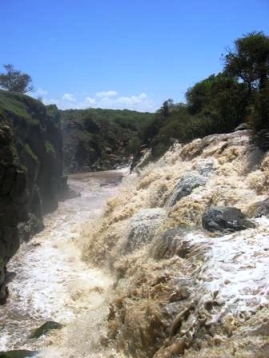Hydrological modeling as a tool for water resources management
Hydrological modeling as a tool for sustainable water resources management: A case study of the Awash River Basin.

Project leader: Berit Balfors
Participants: Selome Tessema, Ulla Mörtberg, Shimelis Setegn (Florida International University, US)
Key words: hydrological modeling, hydropower, water management, environmental management
Project period: 2009-2011
Funding: SIDA
Project description
The growing pressure on the world‘s fresh water resources is enforced by population growth that leads to conflicts between demands for different purposes. A main concern on water use is the conflict between the environment and other purposes like hydropower, irrigation for agriculture and domestic and industry water supply, where total flows are diverted without releasing water for ecological conservation. As a consequence, some of the common problems related to water faced by many countries are shortage, quality deterioration and flood impacts. Hence, utilization of integrated water resources management in a single system, which is built up by river basin, is an optimum way to handle the question of water. However, in many areas, when planning for balancing water demands major gaps exist on baseline knowledge of water resources. In order to bridge these gaps, hydrological models are among the available tools used to acquire adequate understanding of the characteristics of the river basin. Apart from forecasting and predicting the quantity and quality of water for decision makers, some models could also help in predicting the impacts of natural and anthropogenic changes on water resources and also in quantifying the spatial and temporal availability of the resources. However, main challenges lie in choosing and utilizing these models for a specific basin and managerial plan. In this study, an analysis of the different types of models and application of a selected model to characterize the Awash River basin, located in Ethiopia, is presented. The results from the modeling procedure and the performance of the model are discussed. The different possible sources of uncertainties in the modeling process are also discussed. The results indicate dissimilar predictions in using different methods; hence proper care must be taken in selecting and employing available methods for a specific watershed prior to presenting the results to decision makers.
Aim
The aim of this research is to analyse and characterize the Awash River basin, at the same time exploring the possibilities to use hydrologic models as decision support tools for balancing water use for hydropower, irrigation, households, environmental flows and flood risk management.
Cooperation
Florida International University, US
Publications
| 2015 | Tessema, S.M., Setegn, S.G., Mörtberg, U., 2015. Watershed modeling as a tool for sustainable water resources management: SWAT model application in the Awash River Basin, Ethiopia , in: Setegn, S.G., Donoso, M.C. (eds.), Sustainability of Integrated Water Resources Management. Springer International Publishing, pp. 579-606. |
| 2014 | Tessema, S.M., Lyon, S.W., Setegn, S.G., Mörtberg, U., 2014. Effects of different retention parameter estimation methods on the prediction of surface runoff using the SCS curve number method . Water Resources Management 28: 3241-3254. |
| 2011 | Tessema, S.M., 2011, Hydrological modeling as a tool for sustainable water resources management: a case study of the Awash River Basin . Licentiate thesis, comprehensive summary, KTH Royal Institute of Technology, Stockholm. |
